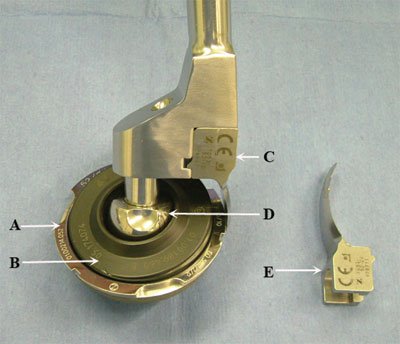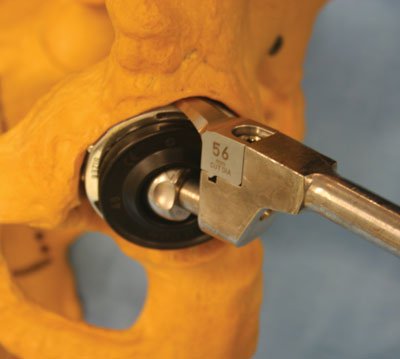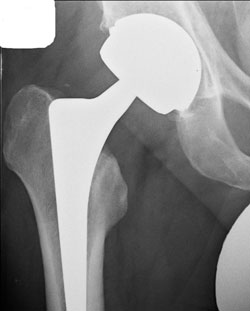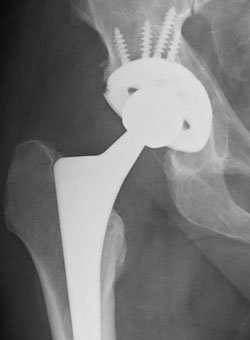Removal of well-fixed hip resurfacing acetabular components: A technical note
Metal-on-metal resurfacing has become an increasingly popular operation in the treatment of arthritis of the hip joint in young, active patients.
At the heart of these metal-on-metal implants are modern-day acetabular components that include monoblock internally smooth cobalt-chromium (CoCr) cups.
The external surface is invariably roughened to some degree to permit bony ingrowth. Despite early promising results, there is still the possibility these may require revision.
Some implants will have to be removed in cases of malposition, causing impingement and pain with or without instability, infection and in some cases due to presence of metal hypersensitivity reaction. Indeed, if the latter becomes an issue, larger number of already implanted acetabular components will require removal.
The aim is to remove this component while causing minimal damage to host bone. Recently, the Explant Acetabular Cup Removal System [Zimmer] has been demonstrated to ease the removal of modular cementless acetabular shells (Figure 1). However this system is not designed to remove resurfacing acetabular components.
|
Images: Patil S |
We present a modification of a previously described technique to remove secure, cementless, monoblock acetabular resurfacing components.
Operative technique
The technique of removing modular cementless acetabular components using the Explant Acetabular Cup Removal System has already been well described in the literature. This system consists of a rotating handle connected to an acetabular liner centering device, which drives a curved cutting blade around the outside of the acetabular shell at the bone-implant interface.
Two blades are used sequentially. The first — a short blade — penetrates the dense peripheral bone, creating a channel, and the second — a thin, full-radius blade — frees the dome of the cup from the pelvic bone. Both blades are tapered at the cutting edges and are approximately 2 mm thick.
|
|
Our modification of this technique is the use of large femoral trial heads that match the internal diameter of any acetabular cup. In the standard modular acetabular cup system, a liner of known inside diameter must be present to position the centering head of the Explant tool in the cup. However, the centering heads of the system are only available in diameters of 22, 26, 28 and 32 mm.
To match the internal diameters of all resurfacing acetabular components, a large inventory of trial heads is required. We have used the already present large femoral trial heads that match the acetabular component exactly. The 22-mm head of the Explant system fits snugly into the trial large head, permitting accurate centering of the device (Figure 1). This creates a stable construct that remains centered in the acetabular shell.
|
|
|
|
X-rays of a patient who underwent revision with a large metal-on-metal replacement with a resurfacing cup. The revision was needed due to metal allergy, The original femoral stem was retained. Preoperative image is on left; postoperative on right. |
|
Discussion
The existing Explant Acetabular Cup Removal System does not contain suitable sized heads to fit the internal diameter of most resurfacing cups. In addition, standard liners do not fit well into these monoblock shells, as they easily skid out. This is potentially extremely dangerous as the blades of the explant system are extremely sharp and could cause neurovascular damage.
Our modification uses a pre-existing system. The ease of removal with this modification illustrates that the Explant Acetabular Cup Removal System can be safely expanded to permit removal of well-fixed resurfacing monoblock acetabular components. We have successfully employed the described technique to remove resurfacing acetabular components from four different manufacturers in eight patients.
With experience, any manufacturers’ resurfacing shell can be removed with minimal bone loss using this approach.
For more information:Reference:
- Sanjeev Patil, FRCS(Orth);A Mohammed, MD, FRCS(Orth); and R.M.D. Meek, MD, FRCS(Orth), are consultant orthopedic surgeons at Southern General Hospital in Glasgow, Scotland. R.A. Preiss, FRCS)Orth), is a the arthroplasty fellow in the department. They can be reached at Southern General Hospital, Department of Orthopaedics, 1345 Govan Road, Glasgow G51 4TF, Scotland; 44-(0)141-201-2866; e-mail: shailasanjeev@gmail.com.
- Mitchell PA, Masri BA, Garbuz DS, Greidanus NV, Wilson D, Duncan CP. Removal of well-fixed, cementless, acetabular components in revision hip arthroplasty. J Bone Joint Surg (Br). 2003;85(7):949-952.




